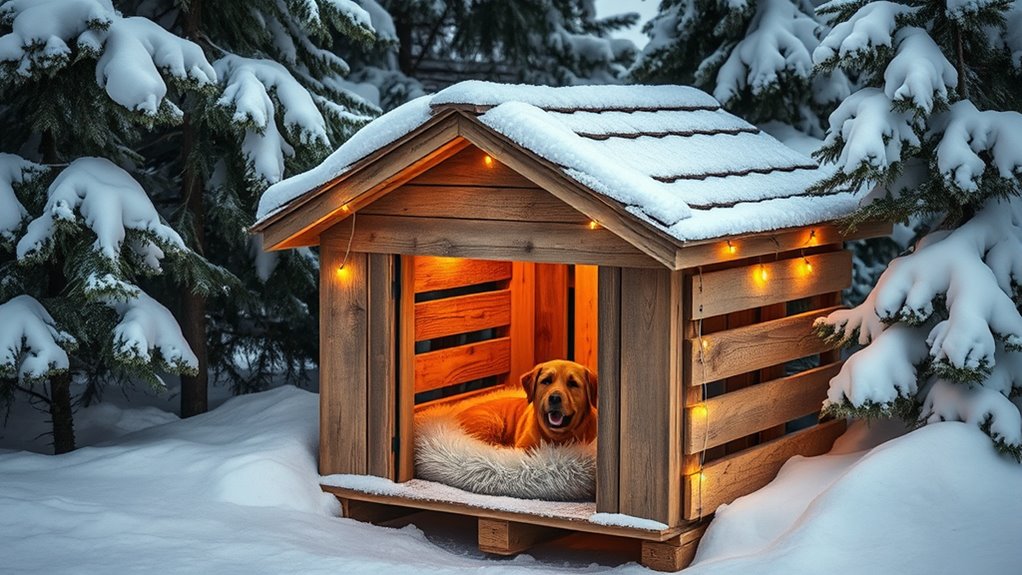To construct a DIY insulated pet shelter for winter, select affordable materials like foam boards, straw, or recycled newspaper, and install them securely to trap heat. Seal any gaps to prevent drafts and guarantee insulation stays dry and mold-free. Use waterproof coverings on the entrance and keep the shelter off the ground to prevent moisture. Regularly check and maintain your shelter to keep your pets warm and safe—more tips await inside.
Key Takeaways
- Choose affordable, effective insulation materials like foam boards, straw, or recycled newspaper, ensuring they are dry and mold-free.
- Seal all gaps around the shelter and insulation to prevent drafts and retain warmth.
- Elevate the shelter off the ground to prevent moisture seepage and improve airflow.
- Cover the entrance with a waterproof flap or door to block wind, snow, and cold air.
- Regularly inspect and maintain the shelter, repairing damage and replacing damp insulation to ensure ongoing warmth.

If you’re looking to keep your outdoor pet warm during chilly months, building a DIY insulated pet shelter is a practical and cost-effective solution. The key to a cozy shelter is selecting the right insulation materials, which help retain warmth and protect your pet from cold winds. Foam boards, straw, and recycled newspaper are popular options because they’re affordable, easy to work with, and provide good insulation. Foam boards are lightweight and effective at trapping heat, but make sure to seal any gaps to prevent drafts. Straw offers natural insulation, stays dry, and is safe for pets, but it may need replacing over time. Recycled newspaper, packed tightly, can serve as a temporary or supplemental insulator, though it doesn’t perform as well as foam or straw in extreme cold. Whichever materials you choose, verify they’re dry and free of mold before installing them inside your shelter.
Once you’ve built your shelter and added insulation, it’s important to focus on shelter maintenance. Regular checks ensure the insulation remains effective and the shelter stays in good condition. Look for signs of wear, such as tears in the covering or gaps around the entrance, which can let in cold air. Repair any damage promptly to keep the interior warm. Additionally, inspect the insulation materials periodically; moisture can reduce their effectiveness and promote mold or rot. If you notice dampness or mold, replace or dry out the insulation as needed. Keep the shelter elevated off the ground to prevent moisture from seeping in and to improve airflow underneath, which further helps maintain a dry environment. Cover the entrance with a flap or door made of waterproof material to block wind and snow, especially during storms, but ensure it’s easy for your pet to access comfortably.
Building an insulated shelter isn’t a one-time task; it requires ongoing shelter maintenance to ensure it continues to serve its purpose effectively. Regular cleaning inside the shelter prevents pests and keeps it inviting for your pet. Also, monitor the temperature inside during freezing weather—if it drops markedly, consider adding additional insulation or a heat source designed for outdoor use. Proper insulation materials combined with diligent shelter maintenance create a warm, safe refuge for your outdoor pet throughout winter. By staying proactive, you’ll help your furry friend stay comfortable and healthy, no matter how cold it gets outside.
Frequently Asked Questions
What Materials Are Best for Insulation in Extreme Cold?
When choosing insulation for extreme cold, you want materials that trap heat and stay dry. For pet bed insulation, consider foam boards or reflective insulation to keep warmth in. For outdoor shelter materials, use straw or hay, which insulate without retaining moisture. Avoid materials that absorb water or mold easily. You can enhance your pet’s comfort by layering these insulative options, ensuring they stay warm and safe during harsh winter conditions.
How to Prevent Moisture Buildup Inside the Shelter?
Imagine your pet’s shelter as a cozy castle; you need proper ventilation to prevent moisture buildup. To avoid ventilation issues and mold, add small vents or a breathable cover. Regularly check for condensation and keep the shelter dry. Using moisture-wicking materials and ensuring airflow helps prevent mold, keeping your pet warm and healthy. Think of it as giving your furry friend a snug, dry haven—like a vintage steamer ready to sail.
Can I Add Heating Elements Safely?
You can add electric heating to your pet shelter, but safety precautions are crucial. Use pet-safe, low-wattage heaters designed for outdoor use, and make certain they have automatic shut-off features. Keep cords away from water and your pet’s reach to prevent electrical hazards. Always monitor the heater, and never leave it unattended. Following these safety measures will help keep your pet warm without risking safety.
How Often Should I Clean and Inspect the Shelter?
You should clean your pet’s shelter at least once a week to keep it hygienic and comfortable. Follow an inspection tips routine by checking for damage, drafts, and moisture every few days. Keep the cleaning schedule consistent and make repairs promptly. Regular inspections ensure your pet stays safe and warm, especially during winter. Staying vigilant helps prevent health issues and maintains a cozy, secure environment for your furry friend.
What Is the Ideal Size for Different Pet Breeds?
When it comes to pet breed sizing and shelter dimensions, you want to hit the nail on the head. For small breeds, a cozy shelter around 2-3 square feet works well, while larger breeds need more room—about 4-6 square feet or more. Make sure the shelter isn’t too tight or too spacious, as comfort and warmth depend on proper sizing. Adjust dimensions to keep your pet safe and snug.
Conclusion
Building this insulated shelter is more than a project; it’s a sanctuary where your pet’s warmth symbolizes your care and compassion. Just as the sturdy walls shield them from winter’s chill, your effort reflects a love that endures through every storm. When you create this haven, you’re not just providing shelter—you’re forging a sacred space of safety and trust, a beacon of hope amid the cold. Your handiwork becomes a silent promise: they’re never truly alone.










